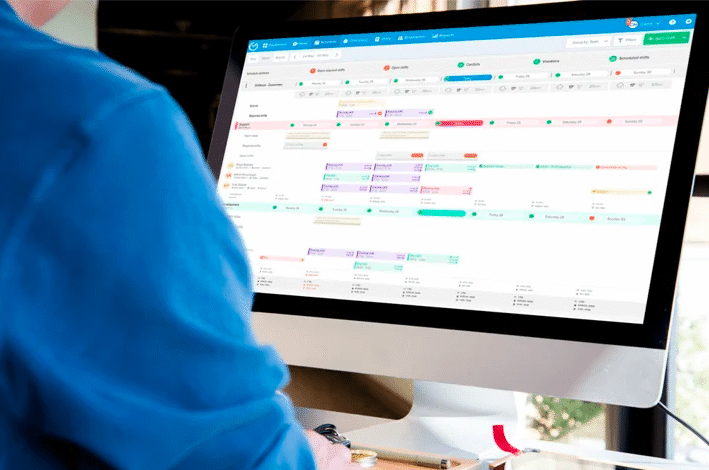Why Every Modern Workplace Needs a Smart roster system

In today’s fast-paced business world, the efficiency of workforce management can make or break an organization. Whether it’s a retail store juggling part-time shifts, a hospital scheduling 24/7 staff, or a tech startup balancing hybrid work weeks, having the right scheduling tools is essential. This is where a roster system becomes a game changer.
Gone are the days when spreadsheets or whiteboards were enough to manage employee shifts. As businesses scale and employee needs diversify, traditional methods simply don’t cut it. A well-implemented roster system not only enhances productivity but also ensures fair workload distribution, legal compliance, and improved employee satisfaction.
This article dives deep into the importance, functionality, and impact of a smart roster system in the HR and recruitment industry—and why it’s no longer optional in 2025.
What Is a roster system?
A roster system is a digital or manual tool that manages employee work schedules. It determines who works, when, and where. Depending on the industry, this system might include rotating shifts, fixed shifts, overtime, on-call duties, or flexible hours.
In modern business environments, a roster system is typically software-driven and integrated with HR, payroll, and attendance systems. It automates scheduling, monitors availability, alerts managers about conflicts, and even allows employees to request shift swaps or time off—making the entire process seamless.
See also: 5 Benefits of Partnering with a Proprietary Firm for Funding
The Core Functions of a roster system
A good roster system performs more than just basic scheduling. Here’s what it can do:
- Time Tracking: Record clock-in/clock-out times to ensure accurate wage calculations.
- Compliance Monitoring: Ensure legal compliance with labor laws (rest days, break times, maximum work hours).
- Integration with Payroll: Sync hours worked directly with payroll for error-free compensation.
- Real-Time Updates: Notify employees instantly of any changes or alerts.
Why Companies Need a Smart roster system
1. Operational Efficiency
A digital roster system streamlines the entire scheduling process. Managers no longer waste time juggling Excel sheets or correcting last-minute clashes. With automation, scheduling becomes faster and more accurate—freeing up HR resources for strategic tasks.
2. Improved Employee Satisfaction
When employees have input on their schedules and can view rosters online, it reduces confusion and improves morale. Features like mobile access, self-service options, and instant notifications empower workers and increase transparency.
3. Reduced Absenteeism and Turnover
A well-structured roster system minimizes understaffing and burnout—key causes of absenteeism. When workers are scheduled fairly and consistently, they’re more likely to stay engaged and loyal to the company.
4. Legal and Contractual Compliance
Every region has its own labor laws regarding work hours, overtime, and holidays. A smart roster system helps HR teams adhere to these regulations, avoiding costly penalties or disputes.
5. Cost Control
By analyzing labor needs and historical data, companies can avoid overstaffing and reduce unnecessary wage expenses. An efficient roster system ensures optimal use of human capital—aligning labor costs with demand.
roster system in Different Industries
While the core purpose of a roster system remains the same, its application varies across sectors:
- Healthcare: Hospitals use advanced rosters to manage rotating shifts, emergency on-call duties, and cross-departmental allocations.
- Retail: Shops rely on real-time scheduling based on customer flow, holidays, and promotions.
- Hospitality: Hotels and restaurants use flexible roster systems to manage weekend, holiday, and event staffing.
- Education: Schools and universities coordinate teaching schedules, substitute management, and exam invigilation using roster tools.
- Manufacturing: Factories ensure proper coverage for 24/7 production lines using automated roster templates.
Key Features to Look for in a Modern roster system
When choosing a roster system, businesses should look for these essential features:
- Cloud-Based Access: Enables remote schedule management and employee access.
- AI-Powered Scheduling: Uses algorithms to predict labor needs and optimize rosters.
- Employee Portal: Allows workers to view shifts, request leave, or swap duties.
- Multi-Site Support: Ideal for businesses operating in different locations.
- Mobile App: Provides push notifications, GPS check-ins, and shift alerts.
- Reporting & Analytics: Tracks attendance trends, overtime, absenteeism, and labor costs.
Implementation Tips for a roster system
Adopting a roster system may involve a shift in your company’s workflow. Here’s how to implement one effectively:
- Define Your Requirements: Understand your staffing model, business hours, and legal constraints.
- Involve Stakeholders: Engage HR, team leaders, and employees early in the process.
- Choose the Right Vendor: Select a system tailored to your industry and company size.
- Offer Training: Ensure all users—especially managers—are trained on how to use the system.
- Monitor & Adjust: Use feedback and analytics to refine your scheduling strategy.
Common Challenges and How to Overcome Them
Despite its advantages, a roster system can face resistance or hiccups if not implemented properly:
- Resistance to Change: Some employees or managers may prefer old methods. Overcome this with training and by highlighting the benefits.
- Data Inaccuracy: Make sure employee details, availability, and pay rates are up-to-date in the system.
- Overcomplicated Interfaces: Opt for systems with user-friendly dashboards and clear navigation.
With the right planning and communication, these issues can be avoided and the transition to digital rosters can be smooth.
Final Thoughts
In a world where efficiency and agility are paramount, relying on outdated scheduling methods is no longer viable. A smart, tech-driven roster system is essential for any business that values its people and wants to optimize its operations.
From reducing errors and improving employee satisfaction to ensuring compliance and lowering costs, a roster system delivers both immediate and long-term benefits. As organizations continue to grow and adapt to hybrid work models, the role of automated scheduling will only become more significant.
If you’re not already using a modern roster system, now is the time to invest in one. It’s not just about managing shifts—it’s about building a smarter, more efficient workplace for everyone involved.




